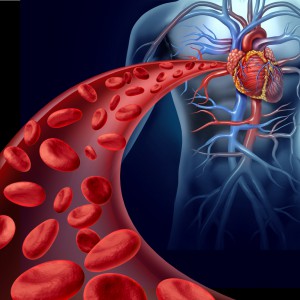Blood Can Be Too Thin or Too Thick

Blood that is too thick can lead to blood clots, and blood that is too thin can lead to easy bruising or bleeding. Problems with blood thickness can occur from birth, or develop later in life. Blood thickness may be affected by foods, drugs, and various medical conditions.
Thick blood may lead to blood clots in the legs, causing a painful, swollen condition called deep venous thrombosis. Sometimes a piece of clot breaks off to lung causing chest pain and shortness of breath- a life threatening condition called pulmonary embolism. Sometimes thick blood causes clots in arteries rather than veins. A blood clot forming in the neck arteries may travel to brain and cause a stroke. A blood clot forming in the arteries of the heart can result in a heart attack. Blood clots cause problems in the affected organ by cutting off oxygen flow.
Thick blood is caused by heavy proteins, or by too much blood in the circulation. Too many red cells, white cells, and platelets will result in blood thickening. Another cause is an imbalance in the blood clotting system. Specific diseases include lupus, inhibitors, deficiency in protein C or S or antithrombin, or mutations in Factor 5 or prothrombin. Cancer can also cause blood thickening.
Not all blood clots are caused by thick blood. Blood clots leading to heart attacks and strokes can be formed when thin blood comes into contact with plaque, which triggers a blood clot. Some blood clots result from sluggish blood flow or poor circulation. People on a long plane or car ride are prone to blood clots if they don’t stretch enough, because of sluggish blood flow in the legs. Obese people are prone to blood clots because their blood flows more sluggishly. An irregular heartbeat called atrial fibrillation causes blood clots, because of sluggish blood flow through the heart.
Blood clots are treated with blood thinners. Some blood thinners like aspirin and plavix make blood platelets less sticky. Others such as heparin or coumadin work by slowing the blood clotting system. Patients are treated with blood thinners for at least 6 months, and sometimes longer depending on the risk of another clot.
Chronic bleeding problems and excessive bruising may be caused by overly-thin blood. Thin blood with bleeding is less common than thick blood with blood clots. Hemophilia and von Willebrand’s disease are two medical conditions that cause thin blood. Hemophiliacs are missing a blood clotting substance, which causes them to bleed into joints. When they start to bleed they are treated with blood thickeners. People with von Willebrand’s disease have easy bruising and bleeding, because their blood platelets lack a sticky coating. Women with von Willebrand’s disease may have heavy periods. A thin-blooded bleeder who needs surgery is given blood thickeners before surgery to prevent bleeding complications.

